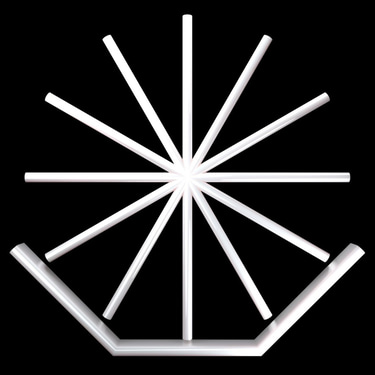Chrysalis: An Interview with Sebastian Loo
Sey Yang
5/15/20247 min read
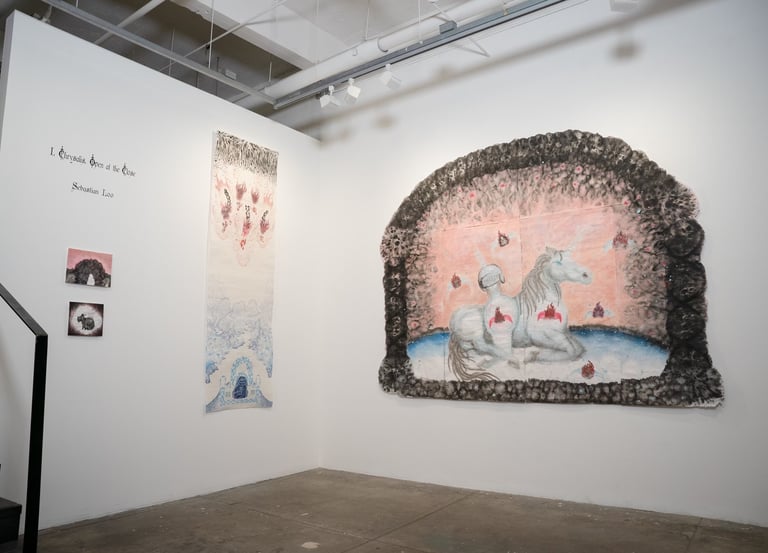

Chrysalis refers to the metamorphosis stage of an insect—when a pupa encloses itself into a cocoon, abandons its adolescent body, and undergoes a vulnerable process of biological dissolution, restructuring, and evolving towards, say, a butterfly, or moth. Within religious or cultural allegories, Chrysalis carries a profound connotation of cycles and rebirth, and personal transition. This transitory stage is accessed in LA-based artist Sebastian Loo’s recent body of work on the spiritual, scientific, and introspective dimensions that are as intimate as they are ubiquitous.
Last April 4th, Loo celebrated the opening of his first solo-exhibition I, Chrysalis, Open at the Close at Soil Gallery in Seattle, Washington. Also one of the many talented artists featured in Graphite’s fifteenth issue, ALMANAC, to be released this June, I took the opportunity to sit down with him in his Mid-City LA studio and had a conversation about his whimsical, acutely lush rice paper paintings.
Sey: Tell me more about Chrysalis! What was your inspiration behind it?
Sebastian: The Chrysalis as a biological process is very dynamic, yet dormant. Reading about Chrysalis, it occurred to me how vulnerable it is to be in that process too, because you are engaged in a process of intentional destabilizing, but for a greater purpose of discovery and the hopes of growth through discovery. But it’s also not certain—you might go into a darker place—you might actually deceive yourself into thinking that some form of reality or experience is something that it actually wasn’t. This past year, I’ve been going through my Saturn return, and I've been revisiting a lot of things that have to do with the core elements that have made me. I’ve been seeing a lot of full circle moments: encountering sites of my upbringing have been shaking my core perceptions of self. Experiences with ending, loss, and change have me reflecting on mortality, death, rebirth, past and future senses of self. Experiences with family have had me reflecting on my understanding of home and security. Everything in my personal life seemed to point to a need for investigating my instruments of meaning-making and methods of perception.
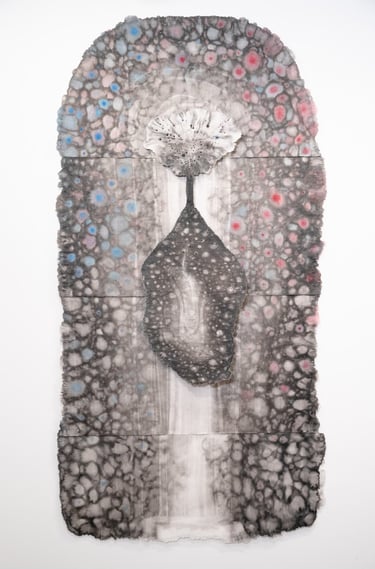


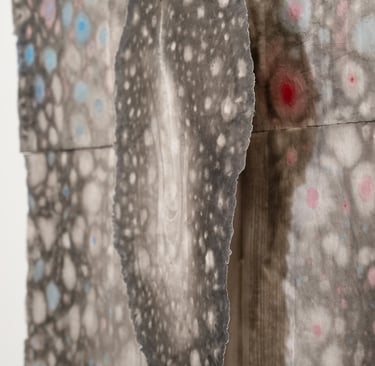
Sebastian Loo, Chrysalis, Held in a Shrine of Cellular Shadows and Temporal Selves, Ink and colors on Xuan rice paper cutout, 54" x 108", 2024
Sey: How are you accessing chrysalis through your material considerations and Pointillist style?
Sebastian: When I install my works such as Chrysalis, Held in a Shrine of Cellular Shadows and Temporal Selves, I am constantly thinking about the fragility of rice paper. It’s constantly in a state of precarity, and definitely doesn’t look like it’s supposed to be archival. When I installed it and it was hanging there, I was like, holy fuck, if someone just opened the door it’s going to go Whoosh, but I love that about it: it made me hold my breath, and there’s something in that weightlessness that I felt like it was helping it do the thing.
My gravitation towards the dot came to me through how it allowed me to explain how all things, from the micro to macroscopic level, are these autonomous agents and have the ability to work on their own, but are never solitary nor isolated units: always part of a larger, open system. Scalability in perspective also became interesting to me; if you zoom out really far back on a planetary level you see the earth as a dot, and when you zoom in really close the dot becomes a cell. In this exhibition, I was really interested in playing with that scalability where I was leaning into molecular pointillism and also more planetary symbolism, but I was also trying to explore dots and “un-dots,” or negative space dots which I would understand as the shadow of a dot where it previously inhabited. Or maybe I even refer to the container or structure that might house the dot, which considers the structure’s permeability or looseness. For me, a large part of the show was also about movement and this scientific process of cellular differentiation to explore these ideas of dots as symbolic organs/cells being rearranged, discarded, or enhanced.
Sey: I definitely see Pointillism as a self-reflexive process for you, like you’re paralleling biological transformation to a form of symbolic death and rebirth, and you’re accessing that through this concept of the dot—not just the image or formal properties of a dot, but also the physical mark-making of a dot as well. How do you start an ink painting? Do you sketch?
Sebastian: No... *chuckles*
Sey: And that’s good—or rather, it can be good depending on the intentionality and I think that works for you.
Sebastian: Definitely. I’ve tried to sketch in the past but it feels like when I sketch, I’m playing with very specific materials. The feeling of pencil on paper is different so my gesture is different, meaning everything is different. The minute something feels planned I feel trapped because I need the process of discovery. I need to be surprised, otherwise I feel like why am I doing it then? My process is a building process; the dots are a way of helping me move slowly and allow the form to mold itself, and I’m discovering the form through this extended exercise.
Sey: I really enjoy how you framed your approach as an instinctual and childlike phenomenon in your statement. It seems to me that your process is a tool for discovery rather than a concretely articulated, cognized reflection. Your language surrounding the dot also feels very Buddhist in the idea of non-self—you’re made up of all the different parts of yourself but you’re not exactly any of them. Of course, I’m visually seeing a lot of Buddhist and Daoist imagery in these paintings as well as Christian influences, and given your use of Chinese materials like ink and rice paper scrolls, I was wondering if you could speak more to this hybridity.
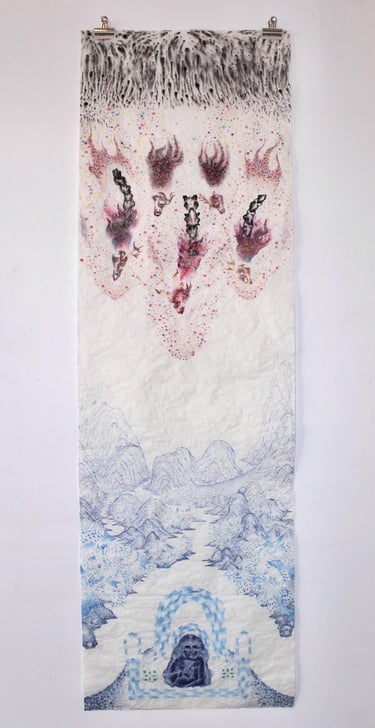



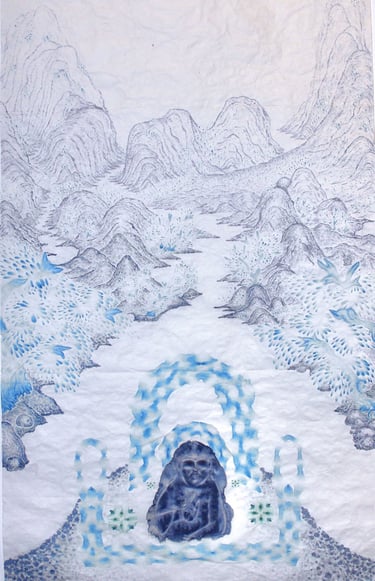

Sebastian Loo, Flying or Falling: bb Luci and friends to Daoist regions, embracing suffering and acknowledging faults for the purpose of growth? Chinese ink on rice paper, 27" x 54", 2024
Sebastian: I felt that bringing different religious subjects together might add more complexity to the ways I approach metamorphosis processes and self-transformation seen from the metaphysical, biological, spiritual, or allegorical icon. Flying or Falling: bb Luci and friends... is about reimagining Lucifer’s grappling with perspective as he is flying or falling into some form of Hell. But Hell here is kind of rendered as a Daoist landscape, suggesting that he is embracing this as the start of a spiritual journey and it's really up to him to understand or be who he is. It's up to him to embrace responsibility and true honesty as to understanding how his sense of past, present, and future self are either “true” or misconstrued by self-delusion. Obviously this isn’t the only time someone has thought of Lucifer’s fall before—George Milton and William Blake are artists who are into taking icons like Lucifer and making a new story with them. While icons also play a significant role in Buddhist traditions, to me there’s still an emphasis on the internal journey and cultivation over prayer and worship.
Sey: For sure, the way I’ve approached Buddhism is very secular too. In the same way that you get to Heaven by praying, you have to do the work for Enlightenment too, and it’s all about the consistent training of your mind to see the world differently than how we are conditioned to see it, to form a deeper connection with the time and space you inhabit.
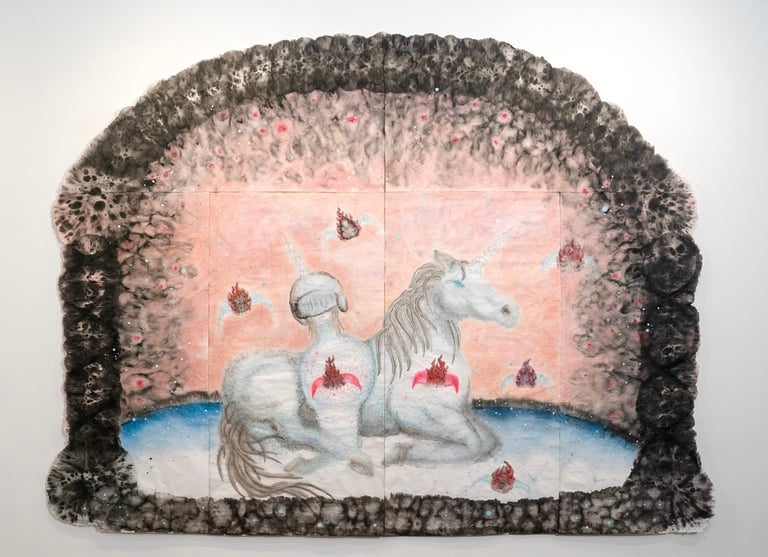

Sebastian Loo, ‘Inside the Chrysalis’: The hunt for (The Unicorn) internal and external manifestations, Ink and colors on Xuan rice paper cutout, 80" x 100", 2024
Sebastian: I am definitely thinking about this in 'Inside the Chrysalis'. I became really interested in the unicorn as an allegorical symbol of purity in both secular, occult, and overtly Christian or Buddhist stories, where the unicorn is hunted to acquire some idealistic form of purity that would restore a personal sense of innocence or purity; it might heal someone of “sin” or it might be some kind of ultimate cosmological solution for the restoring of balance between humans and nature. While in a state of dissolution and material/energetic restructuring, the unicorn and figure meld together and become a collective entity of purity. I'm striving to connect relevance realization, cyclical meaning, and iconography to suggest that the understanding or “truth” we are looking for becomes available once we begin to strip the layers of illusion that cloud our frames of reality. This process ultimately closes the distance between us and inner consciousness. That is to say, embracing our intuition and innate meaning-making processes allow us to cultivate an essential purity of self.
Three of Loo’s paintings will be featured in Graphite this upcoming issue. If you are in LA this June, be sure to attend our launch party at the Hammer to grab a free copy!
